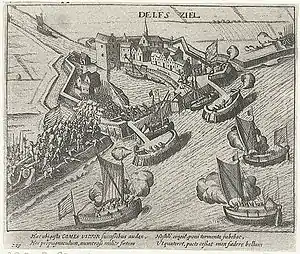Capture of Delfzijl
The Capture of Delfzijl took place during the Eighty Years' War and the Anglo–Spanish War by a Dutch and English army led by Maurice of Orange.[3] The siege commenced on 26 June and lasted until the Spanish troops surrendered the city of Delfzijl on 2 July 1591.[2][4]
| Capture of Delfzijl | |||||||
|---|---|---|---|---|---|---|---|
| Part of the Eighty Years' War & the Anglo–Spanish War | |||||||
 Siege of Delfzijl July 1591; from the workshop of Frans Hogenberg | |||||||
| |||||||
| Belligerents | |||||||
|
|
| ||||||
| Commanders and leaders | |||||||
|
|
| ||||||
| Strength | |||||||
| 9,000 |
300 10 guns[2] | ||||||
| Casualties and losses | |||||||
| Low | All surrendered[3] | ||||||
Events
Background
In early 1591, Maurice had begun a campaign to push the Spanish out of the Netherlands - the States General of the Netherlands wanted Nijmegen to be taken, but complications arose of its capture, so surrounding towns and cities such as Zutphen and Deventer had to be taken before any siege took place. The strategy was to draw the Spanish troops and make them think the real objective was elsewhere. First Zutphen and then Deventer were both taken by Dutch troops under Maurice and English troops under Francis Vere respectively.[5] The next target was Groningen in the North as two years before William Louis, Count of Nassau-Dillenburg, had captured a sconce at Zoutkamp, providing an initial impetus to eventually besiege Groningen. This was soon abandoned by Maurice as it was still considered too strong to besiege, and in addition the threatened approach of the Duke of Parma with his army.[2]
Capture
Maurice instead went directly to the North - his target was the town and fortress of Delfzijl which lay on the shores of the Dollart, a large inlet dividing the province of Groningen from the German district of Emden, a Spanish supply base.[4] On June 26, 1591, the Anglo-Dutch army came before the fortress - they had used 150 boats along the waterways to transport their heavy artillery.[1] The Spanish garrison in Delfzijl numbered only 300 troops and ten guns and both sides knew they were in for a short siege. Siege positions were established in front of the town and when the guns were all in position, they opened fire.[4] Sure enough after a heavy bombardment in the first few days of the siege the Spanish garrison, realising no relief was forthcoming, had had enough and began negotiations for surrender on 2 July.[2] Maurice eventually agreed and the Spanish garrison surrendered and was allowed to leave (except for the disloyal and defectors) under terms for Groningen.[1]
Aftermath
Francisco Verdugo, the Spanish governor in the province of Groningen, was enraged when they arrived there.[3] He ordered the captains beheaded and then humiliated the soldiers. Twelve soldiers were chosen by a lot to be imprisoned; five of these were also beheaded later.[3]
Maurice, after taking Delfzijl, reinforced the fortifications there according to the original plans of Johan van den Kornput and placed a small garrison of Dutch and English inside. In early 1594, the garrison was able to repel a Spanish attack led by Francisco Verdugo.[1]
Maruice then marched from Delfzil and advanced towards Hulst and Nijmegen. Maurice and the Dutch and English army instead had to come before Knodsenburg where they defeated the Duke of Parma attempting to besiege the place.[3][4]
References
- Citations
- Wernham, Richard Bruce (1980). List and Analysis of State Papers, Foreign Series: June 1591-April 1592, Volume 1; Volumes 3-4. H.M. Stationery Office. ISBN 9783601002314.
- Kuypers, F.H.W. (1871). Geschiedenis der Nederlandsche artillerie van af de vroegste tijden tot op heden, Volume 2 (Dutch). p. 233.
- Julsing pp 117-18
- Markham 175
- van der Hoeven p 40
- Bibliography
- Wernham, Richard Bruce (1980). List and Analysis of State Papers, Foreign Series: June 1591-April 1592, Volume 1; Volumes 3-4. H.M. Stationery Office. ISBN 9783601002314.
- Tracy Borman (1997). Sir Francis Vere in the Netherlands, 1589-1603: A Re-evaluation of His Career as Sergeant Major General of Elizabeth I's Troops. University of Hull.
- Julsing, Johan (2006). Het geheime dagboek van de Groninger stadssecretaris Johan Julsing 1589-1594 Volume 2 of Groninger bronnen reeks (Dutch). Uitgeverij Van Gorcum. ISBN 9789023242345.
- Markham, C. R (2007). The Fighting Veres: Lives Of Sir Francis Vere And Sir Horace Vere. Kessinger Publishing. ISBN 978-1432549053.
- van der Hoeven, Marco (1997). Exercise of Arms: Warfare in the Netherlands, 1568-1648 Volume 1 of History of warfare. BRILL. ISBN 9789004107274.